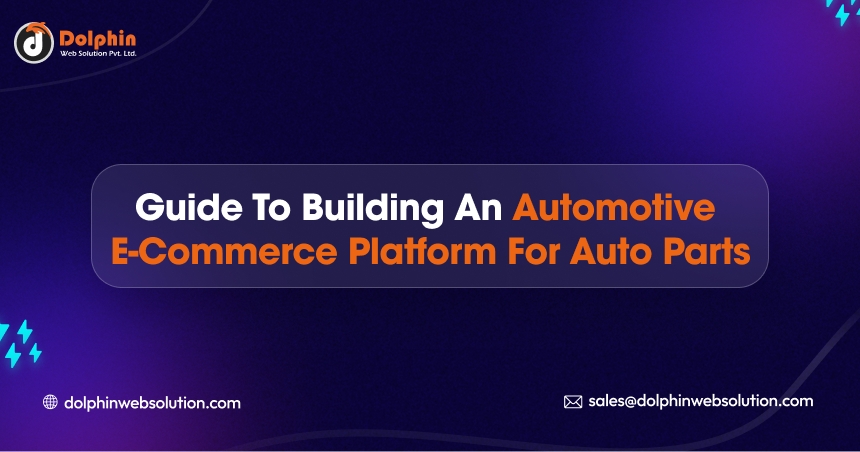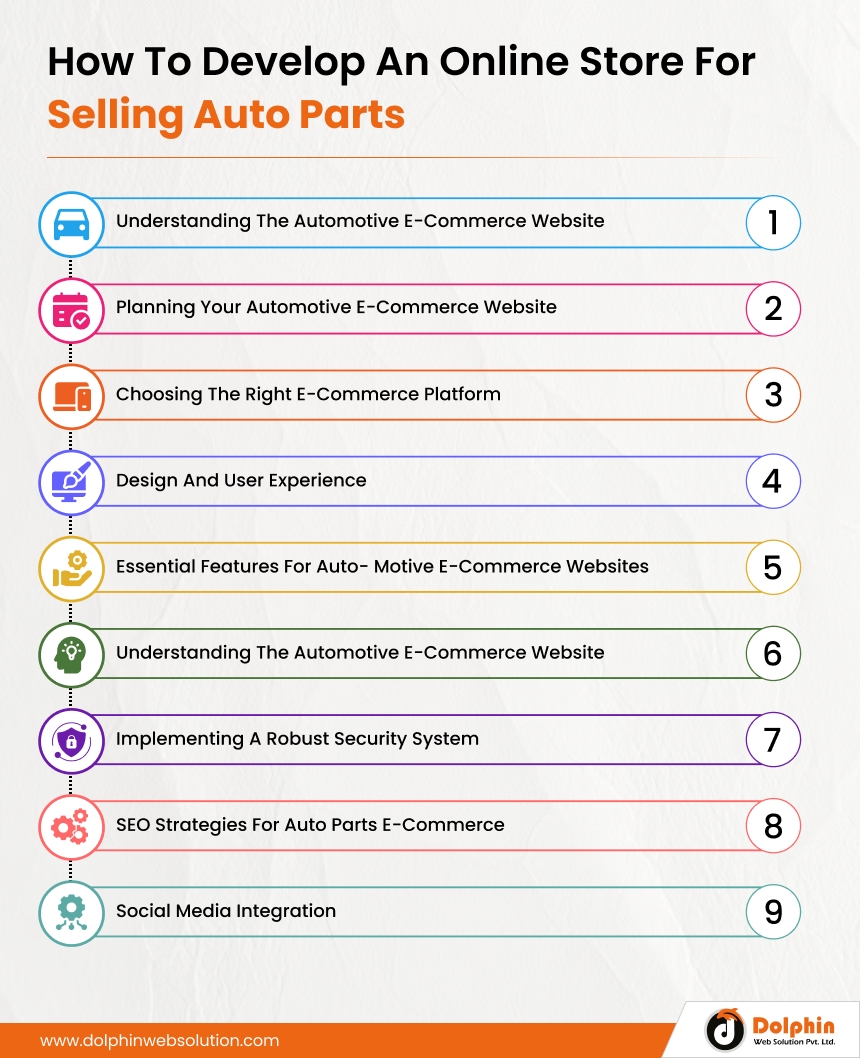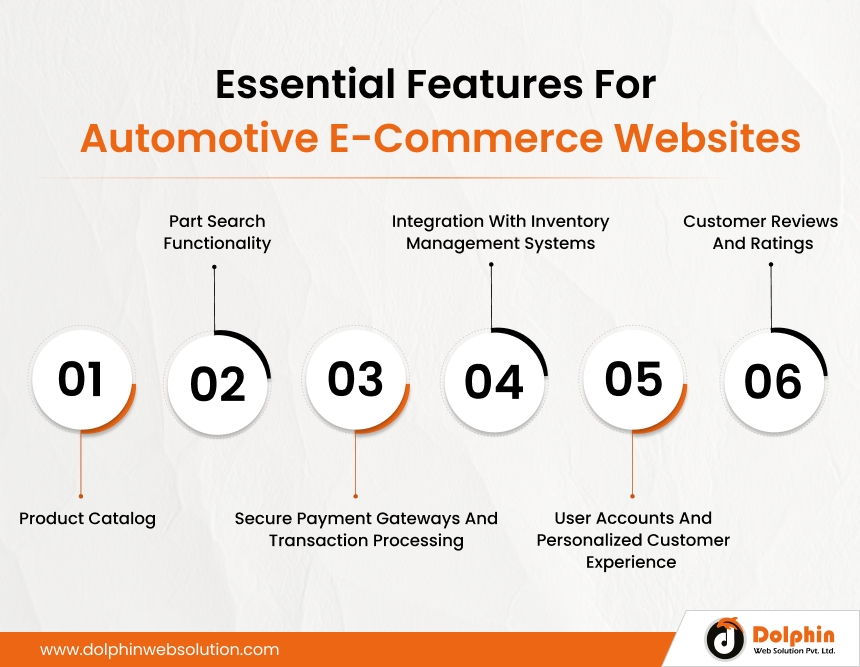How To Develop Auto Parts Ecommerce Website?

Table of Contents
Summary :
Gone are the days when people visited brick-and-mortar stores to buy things. According to a report, 22% of total auto parts sales in 2023 were online. Developing an eCommerce automotive store will be rewarding only when you integrate the right website features. Let us understand what makes a successful online auto parts website.
Around 62% of US millennial car buyers aged 22-37 years buy auto parts online. The market size of the Online Automotive Parts and Accessories Sales industry, as measured by revenue, was $11.7bn in 2023. The global eCommerce automotive market is expected to reach $213.08 billion by 2029. This represents a 16.02% annual growth rate from 2022 to 2029, which is much higher than other industries.
The availability and affordability of auto parts on online platforms compared to offline stores will boost the potential of the eCommerce automotive sector. However, you need a robust eCommerce development strategy to enter this growing industry. Auto parts ecommerce webiste development is not easy task you must need proper guide so in this article will discuss guide on how to develop an online store for selling auto parts with features to consider, choosing the right eCommerce platform, SEO optimization, and website launch.
How to Develop An Online Store For Selling Auto Parts
If you want to develop a commercial website that caters to users looking for specific auto parts, here is all you need to know.

1. Understanding the Automotive ECommerce Website
Know your customers, what is in demand, what your customers are looking for, and what you can offer to your customers. When developing an auto part eCommerce website, there are two primary types of websites — B2B and B2C. Understanding which kinds of auto parts you want to sell and your target audience is essential.
If you wish to sell auto parts to other automotive businesses, opt for a B2B automotive website. In contrast, if you want to sell auto parts to end users directly, you can develop a B2C automotive website. Add images and videos to your product pages and integrate more detailed descriptions to guide your users better. Keep efficient options for payment, returns, and shipping.
2. Planning Your Automotive ECommerce Website
When planning your automotive eCommerce website, first decide your target audience and product offerings. Then, select the features you want to integrate into your website, such as easy navigation, fast speed, advanced filters, intuitive search functionality, multiple product displays, and integrations, secure payment.
You must also decide on your website development budget and the eCommerce platform you want to use. WooCommerce, Shopify Plus, BigCommerce, etc, are some of the top platforms for B2B portals.
3. Choosing the Right E-commerce Platform.
Auto parts are one of the most profitable eCommerce niches that can deliver fast results. However, you need to integrate the best functionality and features. You must also decide on your website development budget and the eCommerce platform you want to use. WooCommerce, Shopify Plus, BigCommerce, etc, are some of the top venues for B2B portals.
4. Design and User Experience
Your website should have UX that drives results and leaves a positive impression on your users. Use easy-to-read fonts and beautiful graphics. Compress and optimize your pictures for fast loading speed. Choose an audience-appropriate website language.
Also, it would help if you tried to bring consistency to your website design and integrate visible call-to-action buttons.
5. Essential Features for Automotive ECommerce Websites
When developing an automotive eCommerce website, make sure to not miss out on these crucial features:

1. Product Catalog
When structuring a product catalog, you need to import standardized and credible auto parts data and then successfully convert it into a product listing. It would help to have fast bulk import options and robust integrations with trusted data networks for auto parts such as AutoSync, ASAP network, SEMA data, etc.
2. Part Search Functionality
When a user searches on your website, they want to filter out unwanted products. Having filtered navigation on your website will help narrow the results for your customers and help them look for their required auto parts faster.
Users can refine their auto part searches based on what is available for their specific search term on your site about category, brand, price range, condition, and year. This will be particularly helpful if you wish to deliver an extensive catalog to your users.
3. Secure Payment Gateways and Transaction Processing
You can use APIs to set up your checkout and payment pages efficiently. You should be able to understand the purchasing behavior of your customers and act on them immediately. Use APIs that are scalable and flexible and offer top-notch support.
Choose payment gateways that will speed up the entire transaction process and offer multiple payment options to your customers.
4. Integration with Inventory Management Systems
If you want to save time manually fulfilling orders, managing inventory, and struggling with delivery times, you must opt for efficient inventory management systems. These integrations will help you manage your product catalogs and stock effortlessly across multiple distribution channels, manage returns better, and improve the quality of your shipping service.
5. User Accounts and Personalized Customer Experience
There are multiple ways that websites can implement personalization in their automotive websites. As an automotive e-commerce company, you can use data on browsing history, purchase history, and search queries to determine the preferences and interests of your users. You can then utilize this information to personalize the website experience for that specific user. Also, create user accounts to store wish lists, billing information, search history, product information, etc. This will boost your conversions and sales.
6. Customer Reviews and Ratings
Encourage your users to leave reviews or ratings on your auto parts eCommerce store. This will build customer trust and improve your brand reputation. Customers will feel more confident when purchasing from your website.
6. Implementing a Robust Security System
When developing an auto part website, it is essential to integrate security features. Many auto parts websites provide products that are difficult to find elsewhere or are highly expensive. If your website lacks adequate security, hackers can use this to breach your site’s databases, harm your business, and steal important information.
Users leave sensitive information on your site, such as home addresses and credit card numbers. If hackers get hold of this information, they can use it for identity theft and other malicious uses. The security of your auto part website will show the overall credibility. If a website is secure, it will reflect the efforts that you are making to protect your customers’ information. This will instill confidence and trust in the website and boost your customer retention abilities.
Security features such as SSL encryption, up-to-date software, server-side and client-side validation, etc, should be integrated into your website.
7. SEO strategies for auto parts e-commerce
If you wish to offer your users a variety of auto parts and get more customers, you can opt for dynamic SEO. Dynamic tagging of meta descriptions, page titles, and other SEO elements will provide fast SEO results. Also, you must understand that not all users know the auto part name and may use a part number when searching for the product. When optimizing your website for auto parts, check whether the part number has a substantial search volume. This will allow you to capture a broader audience looking for these products.
Include more long-tailed terms that include the makes and models of vehicles. Use keyword research tools to search for the highest-volume keywords relating to specific vehicle’s auto parts and optimize them. It would help if you also tried integrating detailed specifications to maximize SEO for your auto parts through Google’s featured snippets.
Optimize the load speed of your web pages to get the best SEO results.
8. Social Media Integration
To boost the sales on your auto parts website, opt for social media integration. Many users like to check out a brand’s social media first before visiting the website. Linking your eCommerce website with your social media accounts will drive your traffic from all directions.
Add your social media icons on your website and product pages. You can also share your product offerings and other content on your social media profiles. This will build brand awareness and improve sales.
Also Read:
How to Start a Jewelry Business Online9. Launching Your Automotive E-commerce Website
The first step to creating an automotive eCommerce website is to build a visually compelling home page with high-quality images and videos. Next, integrate year, make, and model lookup in your search navigation. An intuitive category navigation is essential to retain customers and boost sales. Integrate product merchandising and website promotions to expand your reach further. Once you incorporate all the features and integrations, it’s time to launch your eCommerce website.
Types of Auto Parts Which You Can Sell
- Engine Parts
- Drivetrain Parts
- Braking System Parts
- Suspension and Steering Parts
- Fluids and Chemicals
- Brake Parts
- Body Parts
Cost to develop Auto Parts E-commerce Website
Usually, eCommerce website development cost around $10,000 to $500,000. The cost to develop an auto parts eCommerce website will depend on the complexity of your platform selection, such as WordPress, Magento, Shopify, etc., your website’s design, the number of web pages, extensions, plugins, and other factors. The profits and success of your website will depend on the combination of strategies and tools used for your online store development.
Conclusion
When developing any eCommerce website, you should prioritize user convenience and experience. With the right eCommerce development team by your side, you can create a successful auto part website with all the products, features, and comfort your users would like. Ensure your website is SEO optimized and your marketing efforts are on point. Continuously try to improve customer experience and prioritize security in each transaction. If you are looking for develop Auto Parts ecommerce website development for your business then contact to dolphin web solution team.

Hello!
Click one of our contacts below to chat on WhatsApp


